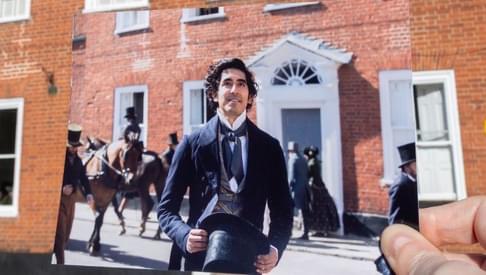
Back to Blogs
Discover
Explore Bury St Edmunds' Literary Connections!
Charles Dickens, Ruth Rendell, Norah Lofts and the bard himself, William Shakespeare have included Bury St Edmunds in their works.
Charles Dickens: The Pickwick Papers, David Copperfield and The Angel Hotel

The Charles Dickens Suite at The Angel
You can’t miss the blue plaque at the front of The Angel Hotel, installed on the 200th anniversary of Charles Dickens’s birth to commemorate his three visits.
Dickens first stayed at The Angel in 1835 as a journalist for the Morning Chronicle (staying in what was then room 11).
In 1859 and 1861 he returned to read to a captive audience at the nearby Athenaeum, staying in what is now room 215, AKA the Charles Dickens Suite.
Bury St Edmunds and The Angel itself feature extensively in The Pickwick Papers. In Chapters 16 Mr Pickwick and his manservant Sam arrive at Bury St. Edmunds, on the trail of the charlatan Alfred Jingle:
"Beg your pardon, sir,' said Sam, suddenly breaking off in his loquacious discourse. “Is this Bury St. Edmunds?”
'It is,” replied Mr. Pickwick.
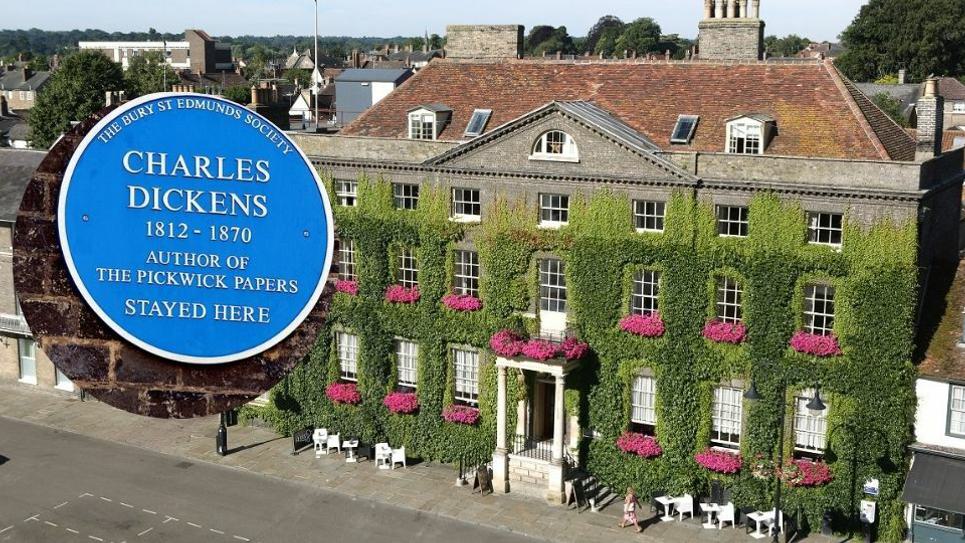
The Angel Hotel where Charles Dickens stayed
The coach rattled through the well paved streets of a handsome little town, of thriving and cleanly appearance, and stopped before a large inn situated in a wide open street, nearly facing the old abbey.
“And this,” said Mr. Pickwick, looking up, “is the Angel! We alight here, Sam.”
When Sam and Pickwick hear Jingle plans to elope with a girl from a nearby boarding school, Pickwick hides in the school grounds as part of a plan to save her, causing panic among the teachers and boarders “all half-dressed and in a forest of curl-papers”. It is thought this school may have been based on a school open in the 1850s on 42 and 43 Southgate Street.
Bury St Edmunds is again mentioned in 'The Personal History of David Copperfield':
‘What is your part of the country now?’ I asked, seating myself near him.
‘I am established within a few miles of Bury St. Edmund’s, sir,’ said Mr. Chillip.
From his diary, we know Dickens was very fond of Bury and its inhabitants. "Last night I read Copperfield at Bury St Edmunds to a very fine audience,” he wrote. “I don’t think a word – not to say an idea – was lost.”
Scenes for the movie ‘The Personal History of David Copperfield’ based on Dickens' novel, directed by Armando Iannucci and starring Dev Patel, were shot in Bury St Edmunds in July 2018. The film was released in 2019, 185 years after Dickens first stayed at The Angel in Bury St Edmunds.
William Shakespeare’s royal drama in Bury St Edmunds’ Abbey
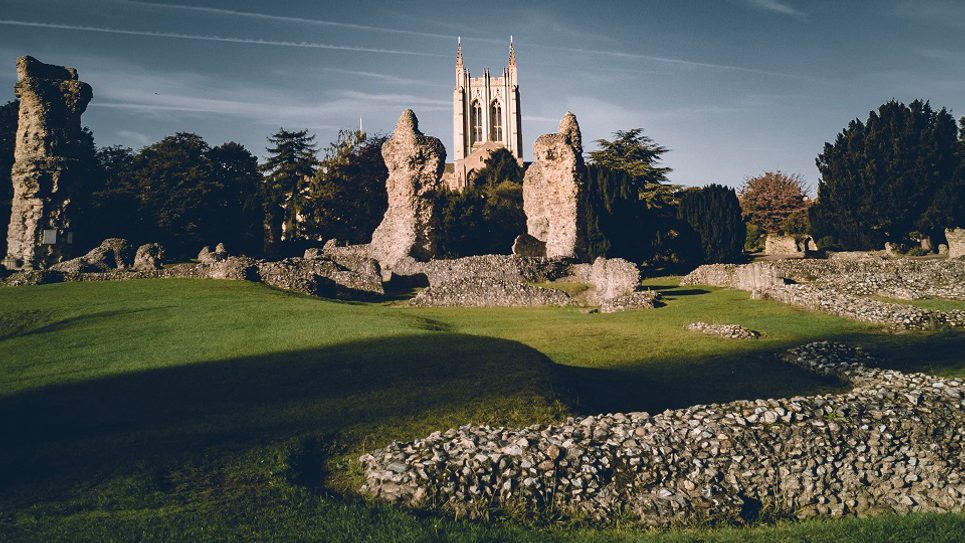
The Abbey Ruins. Photo: Jon Miles
In Henry VI, Part II, Shakespeare dramatises King Henry VI’s summoning of parliament to the Abbey in Bury St Edmunds, and the death of the Duke of Gloucester. The Abbey ruins can be seen in the town’s stunning Abbey Gardens today.
Humphrey, Duke of Gloucester, was allegedly murdered at St Saviours Hospital on Fornham Road near the Abbey’s North Gate. This medieval hospital was the town’s most prestigious, originally established in the late 12th century for ailing monks. The ruins can still be seen: look out for the plaque recording the Duke’s suspicious death here in 1447.
As uncle of Henry VI and heir to the throne, the Duke of Gloucester was a powerful man with many enemies, including the Duke of Suffolk. In Shakespeare’s drama, it is Suffolk who accuses Gloucester of treason.
Norah Lofts’ House at Old Vine
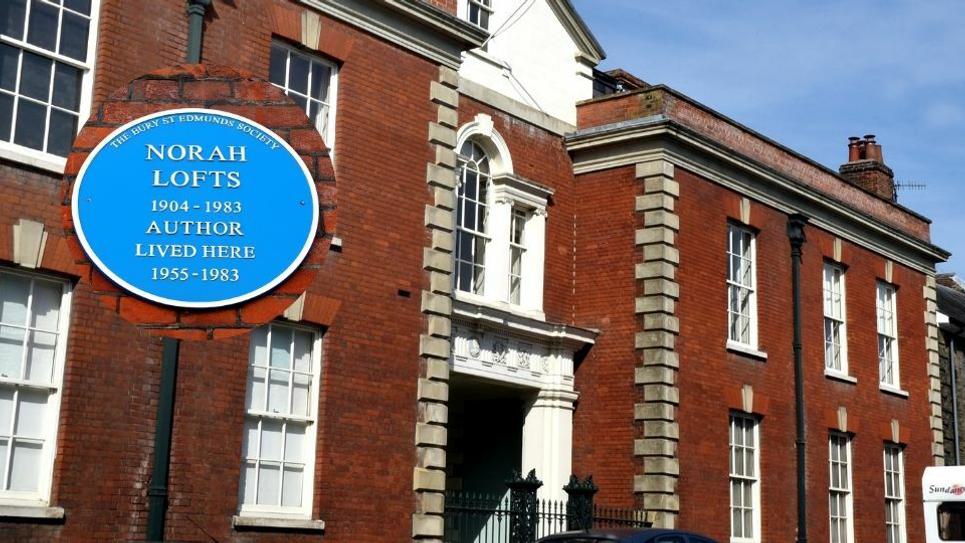
Norah Lofts' home in Northgate Street. Photo: Andy Abbott
Best-selling author Norah Lofts lived in Bury St Edmunds from the age of 10, and a blue plaque signifies the house on Northgate Street where she lived until her death in 1983.
At Northgate House (pictured), Lofts wrote more than fifty books, several of which were made into films. Often considered her finest work, the Suffolk Trilogy, published between 1959 and 1963, was described as “the most outstanding historical novel that I have ever read” by The Independent’s Alison Weir, who calls Lofts “one of the great writers of the twentieth century”.
These books tell the stories of a cast of characters connected with The House at Old Vine, a townhouse set in Baildon, a fictional version of Bury St Edmunds, from the late 14th century through to the 1950s.
Ruth Rendell: murder and mystery in Bury St Edmunds
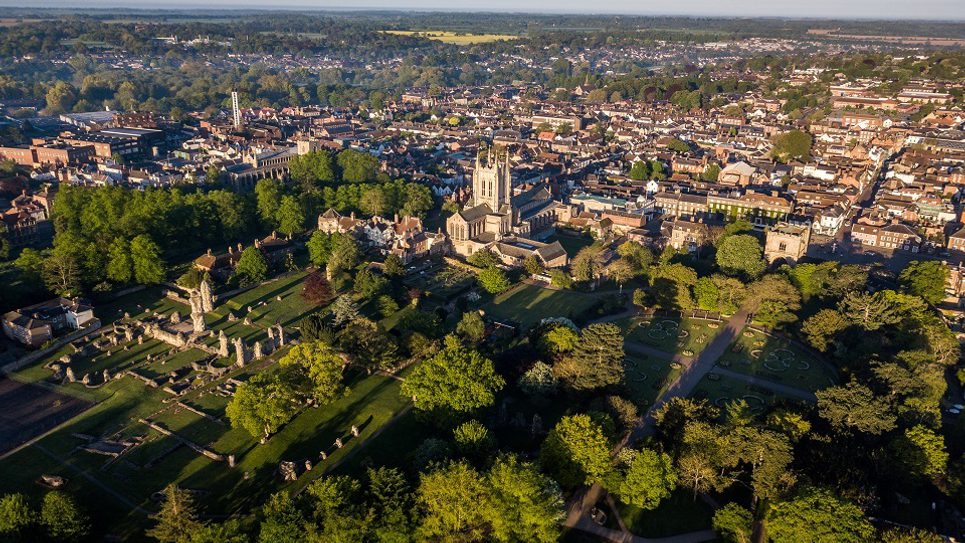
Photo: Birds i images
Suffolk’s Queen of Crime, Ruth Rendell chose Bury St Edmunds and its surroundings as the setting for The Brimstone Wedding. Rendell lived in the village of Polstead for part of her life and was very familiar with West Suffolk.
Written under the pen name Barbara Vine, The Brimstone Wedding is a murder mystery exploring love and madness.
“And it isn’t quite true that Rex died in a train,” main character Stella says to Jenny when they are discussing the mystery surrounding the man’s death. “He was taken ill in a train. He died in hospital in Bury.”
Defoe, Wilde, Kingsley and Thackery Visited
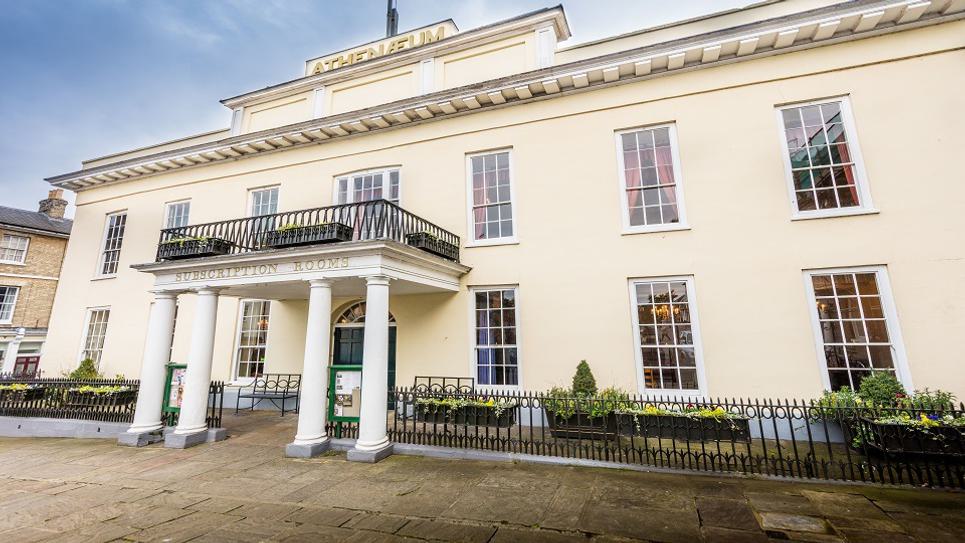
The Athenaeum
Throughout the centuries, Bury St Edmunds has drawn many other literary greats, including Daniel Defoe, author of Robinson Crusoe, who visited in the 1720s.
“It is a town fam’d for its pleasant situation and wholesome air, the Montpelier of Suffolk, and perhaps of England,” he wrote of St Edmund's Bury in his three volume travel book, Tour Through the Whole Island of Great Britain which was published between 1724 and 1727. It was innovative at the time partly because Defoe had actually visited the places he described.
In the early 19th century, poet Samuel Taylor Coleridge visited Thomas and Catherine Clarkson, the leading campaigners against the slave trade, at their home in Horse Market (now called St Mary's Square).
Oscar Wilde delivered a lecture entitled “Personal Impressions of America” in The Athenaeum on Angel Hill on 21 March 1884.
And in 1860, The Athenaeum, which overlooks the Abbey, hosted the Rev Charles Kingsley, author of Westward Ho and The Water Babies, as well as W M Thackeray, author of Vanity Fair.
Thomas Shadwell - Bury Fair
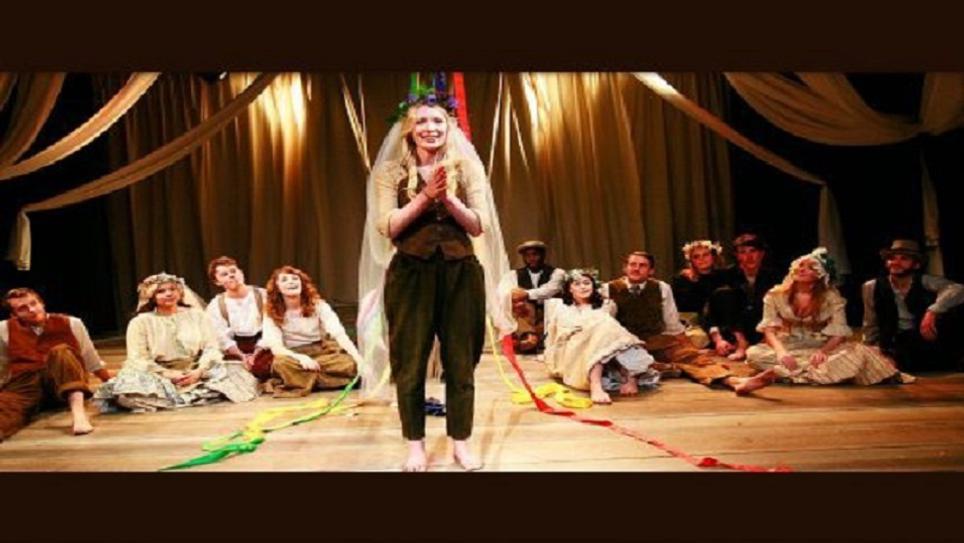
Bury Fair being performed at Theatre Royal Bury St Edmunds
In an affectionate satire of his home town, Thomas Shadwell throws a pair of London sparks and a French pretender into the world of Bury St Edmunds. A pretentious female fop and her mother, a handful of gloriously idiotic local wags and a young woman in disguise as a boy to escape the will of her father - all dance headlong into chaos.
Thomas Shadwell was born at Stanton Hall, Norfolk in 1642, but he was educated at Bury St Edmunds School and at Caius College, Cambridge, he was made Poet Laureate in 1688 and wrote Bury Fair the following year.
Victorian Novelist Ouida
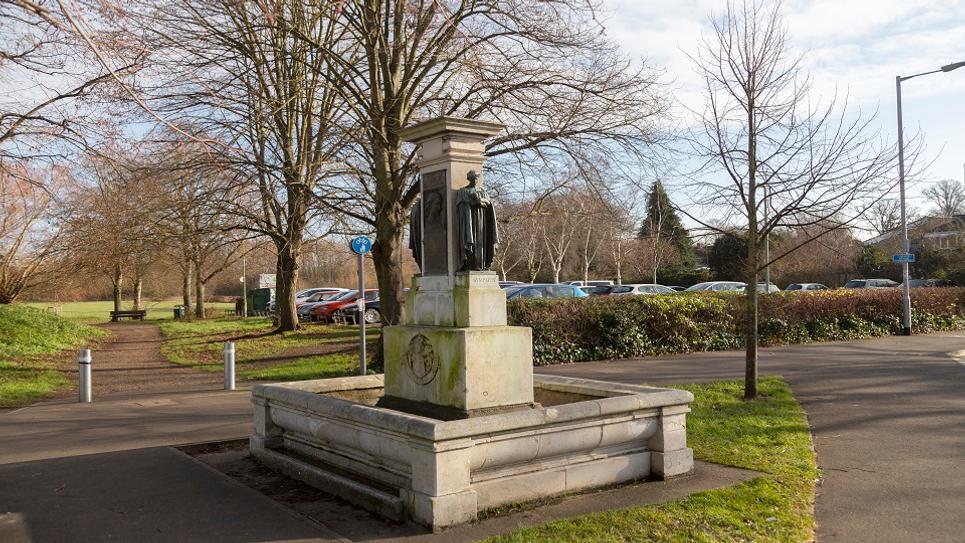
Ouida Memorial in Vinery Road. Photo: Phil Morley
Victorian novelist Marie Louise de la Ramee, who wrote under the pen name Ouida, wrote more than 40 novels, children's books and collections of short stories and essays.
In her early period, her novels were considered "racy" and "swashbuckling", but later her work was more typical of historical romance, though she never stopped comment on contemporary society. She also wrote several stories for children.
Marie was born in Bury St Edmunds in 1839 and lived in Westgate Street but left when she was 18 and in her novelette Blue and Yellow she wrote of her dislike for the town she grew up in.
A memorial tribute to Ouida can be found on Vinery Road in Bury St Edmunds which was funded by readers of the Daily Mirror, friends and admirers.
The two figures on the memorial pay testament to Ouida's character - a sword depicting courage and a lady holding a dog which represents her fondness for animals.
Twinkle Twinkle Little Star
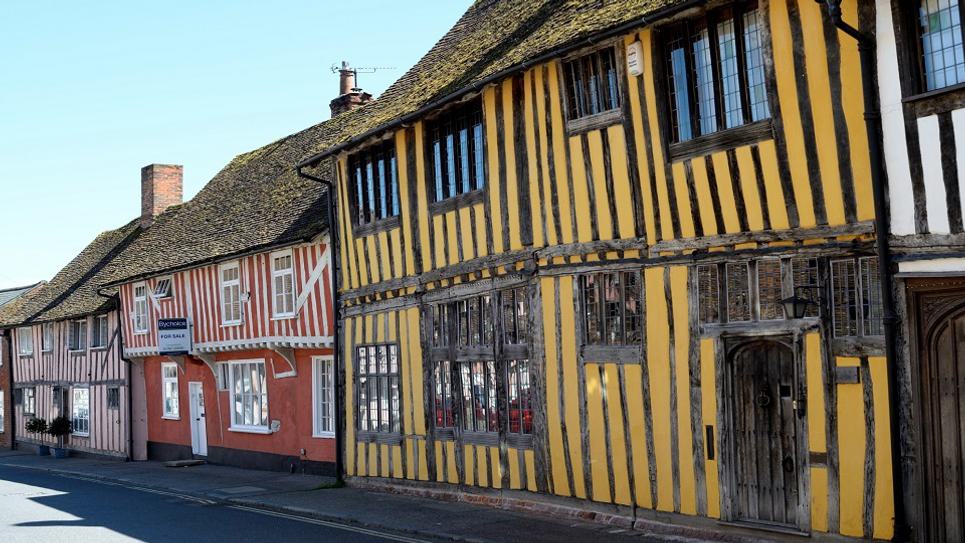
One of England’s most famous lullabies was written by Jane Taylor who lived in Lavenham.
She is thought to have been inspired by her childhood in the medieval village where her family home in Shilling street had a beautiful view of the skyline.
The lyrics are from an early-19th-century English poem by Jane called 'The Star'. The poem, which is in couplet form, was first published in 1806 in Rhymes for the Nursery, a collection of poems by Taylor and her sister Ann. It is sung to the tune of the French melody Ah! vous dirai-je, maman, which was published in 1761 and later arranged by several composers including Mozart.
The lullaby has even found it's way into space. Italian astronaut Samantha Cristoforetti, who holds the world record for the longest time in space than any other woman on a single mission, filmed her own version of Jane's Twinkle Twinkle Star in space at the International Space Station.
Why not explore more of Bury St Edmunds' rich history and book a stay in Bury St Edmunds & Beyond! Take a look at our 'Places to Stay' guide!
Related Posts
Related Blogs

News
Bury Tour Guides to launch…
Bury St Edmunds Tour Guides to Introduce new tours in…

News
Town’s Museum Forms New…
Moyse’s Hall Museum will be forging links with a…

News
St Edmundsbury Cathedral…
St Edmundsbury Cathedral in Bury St Edmunds is…
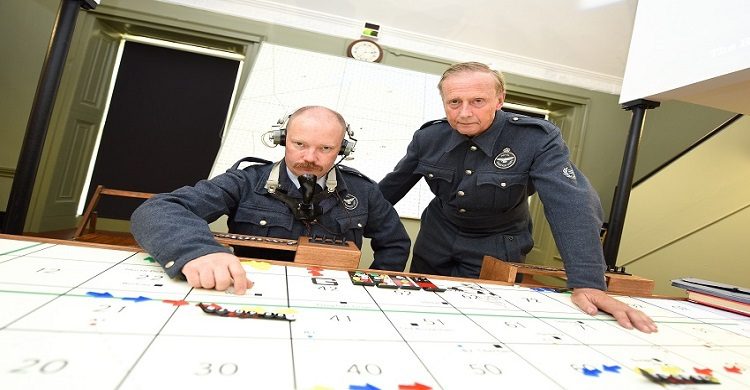
News
Bury St Edmunds & Beyond…
Step inside many of Bury St Edmunds historic buildings…

News
Bury's Best Pubs with a Past
some notable, historic and somewhat quirky pubs and…
Latest news

News
How to Spend Betwixtmas in Bury St Edmunds & Beyond
The post Christmas period is the perfect time to get out and about before the new year kicks in, and you’ll find plenty of activities and places to visit in Bury St Edmunds and beyond.

News
Parents Guide to Pre Christmas Entertainment
It's the school holidays and with Christmas just around the corner we've put toegther a guide on places to take the kids to keep them entertained until Santa visits!

News
Enjoy a Festive Afternoon Tea in 2025
Celebrate the Christmas season with a festive afternoon tea in Bury St Edmunds & Beyond...

News
Festive Winter Walks
Get outside and enjoy the fresh crisp winter air with one of these walks in Bury St Edmunds and Beyond!

News
Bury Tour Guides to launch new tours next year after successful 2025
Bury St Edmunds Tour Guides to Introduce new tours in 2026 and continue the successful Food and Drink Tours!

News
New in Bury St Edmunds For 2026
A sneak peak into new attractions visitors can enjoy in Bury St Edmunds in 2026.

News
Baby It's Cold Outside... Things To Do When the Weather Turns Frosty
Just because the temperature’s dropped doesn’t mean the fun has to! If you’re visiting town during the chillier months, there’s still plenty to see, do, and experience.

News
Places to sit by a roaring fire in Bury St Edmunds & Beyond
Warm up by a roaring fire this winter in Bury St Edmunds & Beyond...

News
Festive Theatre Guide 2025
There’s no better way to summon the magic of the festive season than a trip to the theatre.

